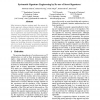ACSAC
2008
IEEE
14 years 6 months ago
2008
IEEE
A new class of stealthy kernel-level malware, called transient kernel control flow attacks, uses dynamic soft timers to achieve significant work while avoiding any persistent ch...
ACSAC
2008
IEEE
14 years 6 months ago
2008
IEEE
Most intrusion detection systems apply the misuse detection approach. Misuse detection compares recorded audit data with predefined patterns denoted as signatures. A signature is ...
ACSAC
2008
IEEE
14 years 6 months ago
2008
IEEE
We propose STILL, a generic defense based on Static Taint and InitiaLization anaLyses, to detect exploit code embedded in data streams/requests targeting at various Internet servi...
ACSAC
2008
IEEE
14 years 6 months ago
2008
IEEE
ACSAC
2008
IEEE
14 years 6 months ago
2008
IEEE
In its most general form, an attack signature is a program that can correctly determine if an input network packet sequence can successfully attack a protected network application...
ACSAC
2008
IEEE
14 years 6 months ago
2008
IEEE
ACSAC
2008
IEEE
14 years 6 months ago
2008
IEEE
Main memory contains transient information for all resident applications. However, if memory chip contents survives power-off, e.g., via freezing DRAM chips, sensitive data such a...
ACSAC
2008
IEEE
14 years 6 months ago
2008
IEEE
Users commonly download, patch, and use applications such as email clients, office applications, and media-players from the Internet. Such applications are run with the user’s ...
ACSAC
2008
IEEE
14 years 6 months ago
2008
IEEE
Many anti-phishing mechanisms currently focus on helping users verify whether a web site is genuine. However, usability studies have demonstrated that prevention-based approaches ...
ACSAC
2008
IEEE
14 years 6 months ago
2008
IEEE
Side channels are typically viewed as attacks that leak cryptographic keys during cryptographic algorithm processing, by observation of system side effects. In this paper, we pres...

